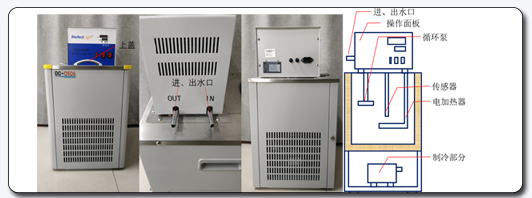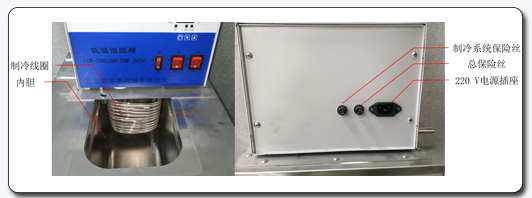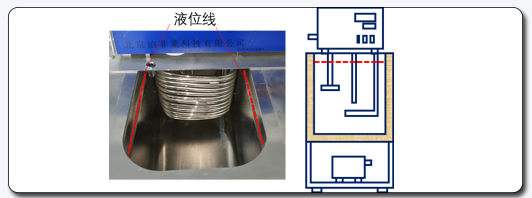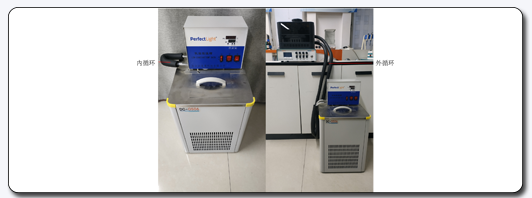A low-temperature constant temperature bath is a device capable of providing controlled cooling, heating, uniformity, and maintaining a constant temperature system for experimental setups. It can also serve as a heat source or cooling source for direct heating or cooling and auxiliary heating or cooling in experimental scenarios.
A low-temperature constant temperature bath can be used for constant temperature experiments in the internal water tank or connected to other equipment through hoses as a temperature source.
Low-Temperature Constant Temperature Bath is widely used in fields such as biotechnology, medicine, food, chemical engineering, metallurgy, chemical analysis, and petroleum, providing users with high-precision, controlled, and temperature-uniform constant heat sources.
1. Components of the Low-Temperature Constant Temperature Bath

Figure 1 Exterior and Schematic Diagram of the Low-Temperature Constant Temperature Bath (Right)

Figure 2 Interior and Back View of the Low-Temperature Constant Temperature Bath
2. Installation of the Low-Temperature Constant Temperature Bath
(1) Remove the packaging of the low-temperature constant temperature bath and clean the low-temperature constant temperature bath and the ground; place it on a stable surface;
(2) Connect the power cord of the low-temperature constant temperature bath;
(3) Open the upper cover of the low-temperature constant temperature bath, and depending on the required temperature for the experiment, fill it with different solutions such as pure water, 15% glycerol solution, or ethylene glycol. Refer to the notes for filling the solution for specific choices. Ensure that the minimum filling level keeps the refrigeration coil completely below the liquid level;

Figure 3 Liquid Level in the Low-Temperature Constant Temperature Bath
(4) Connect the inlet and outlet pipes of the circulating pump: During use, the low-temperature constant temperature bath can be used in two ways: internal circulation and external circulation:
① Internal circulation: used as a water bath alone. The circulation pump of the low-temperature constant temperature bath does not need to be connected to external equipment. The hose can be short-circuited between the "inlet" and "outlet" pipes.
② External circulation: connected to external equipment. The circulation pump of the low-temperature constant temperature bath is connected to external equipment with two hoses, with the "outlet" pipe connected to the "inlet" of the external experimental container and the "inlet" pipe connected to the "outlet" of the external experimental container.

Figure 4 Schematic Diagram of Internal Circulation (Left) and External Circulation (Right) Hose Connection
3. Use of the Low-Temperature Constant Temperature Bath

Figure 5 Control Panel of the Low-Temperature Constant Temperature Bath
(1) Depending on the required experiment temperature, different solutions can be added to the low-temperature constant temperature bath;
(2) Turn on the "power" switch;
(3) Lightly press the "function key" to enter the setting state. The upper row displays "SP" as shown in the figure, and the lower row displays the set temperature;
(4) Use the number adjustment keys ▲ "up key" or ▼ "down key" to set the desired temperature for the experiment;
(5) After setting the temperature, press the "function key" again to complete the parameter setting;
(6) Turn on the "cooling" switch to start heating or cooling;
(7) Turn on the "circulation" switch to circulate the solution;
(8) Confirm that there is no leakage or blockage in the pipes;
(9) After use, turn off the "circulation," "cooling," and "power" switches in order.
4. Maintenance of the Low-Temperature Constant Temperature Bath
(1) Place the low-temperature constant temperature bath on a sturdy and stable workbench;
(2) The indoor environment should be free from vibration and harmful gases;
(3) The room temperature should be stable at around 25°C, and it should not fluctuate significantly. Otherwise, it will affect the temperature control accuracy. High room temperatures can affect the heat dissipation of the compressor, reduce cooling efficiency, and may cause malfunctions;
(4) The low-temperature constant temperature bath requires regular maintenance, especially after some period of operation. If you notice a slowing down of the cooling speed, clean the dust on the surface of the low-temperature constant temperature bath, or, under the guidance of an engineer, disassemble the plastic mesh plate of the low-temperature constant temperature bath to remove dust from the compressor and heat dissipation plate;
(5) If impurities or dirt are present in the solution, it should be replaced in a timely manner.
5. Precautions for the Low-Temperature Constant Temperature Bath
(1) Before use, confirm the filling amount of the solution in the bath. The minimum filling amount should ensure that the refrigeration coil is completely below the liquid level. If the amount of solution is too small, it should be replenished in time. A low liquid level during operation will damage the heater;
(2) Choice of filling solution: ① When the required temperature for the experiment is between 5~85°C, pure water or deionized water is generally used; ② When the required temperature for the experiment is between 85~95°C, a 15% glycerol solution can be used; silicon oil should be used when approaching or reaching 100°C; ③ When the required temperature for the experiment is between -5~5°C, ethylene glycol is generally used;
(3) After turning off the cooling switch, if you want to turn it on again, you should wait for an interval of 15~25 minutes according to the actual ambient temperature;
(4) The power supply power should be greater than the total power of the low-temperature constant temperature bath, and the power supply must have a good grounding device;
(5) When the low-temperature constant temperature bath is in operation, do not put your hand into the inner liner of the low-temperature constant temperature bath;
(6) When in external circulation, make sure the upper cover is closed to prevent foreign objects or dust from falling in;
(7) The low-temperature constant temperature bath needs to be regularly cleaned to keep the workbench and control panel clean;
(8) Do not stack debris near the bottom compressor box of the low-temperature constant temperature bath, and ensure good heat dissipation to avoid affecting the service life.